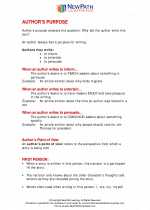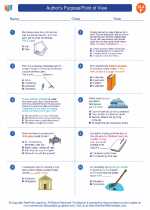Author's Purpose/Point of View
Understanding the author's purpose and point of view is an important aspect of reading comprehension. When we analyze a text, we consider why the author has written it and from what perspective. This helps us to better understand the message and the intention behind the writing.
Author's Purpose
The author's purpose refers to the reason why the author is writing the text. There are three main purposes for writing:
- Inform: The author wants to provide information or explain something to the reader.
- Entertain: The author's primary goal is to engage and entertain the reader through stories, humor, or interesting content.
- Persuade: The author aims to convince the reader of a certain viewpoint or to take a particular action.
Point of View
The author's point of view refers to the perspective from which the story is told. This can include:
- First person: The narrator is a character in the story and uses "I" or "we" to tell the story.
- Third person limited: The narrator is not a character in the story and only knows the thoughts and feelings of one character.
- Third person omniscient: The narrator is not a character in the story and knows the thoughts and feelings of all the characters.
Study Guide
Here are some questions to consider when analyzing the author's purpose and point of view:
- What is the main purpose of the text? Is the author trying to inform, entertain, or persuade the reader?
- How does the author's language and tone contribute to their purpose?
- What is the point of view of the text? How does this perspective impact the reader's understanding of the story?
- How does the author's point of view influence the portrayal of characters and events in the text?
By considering these questions, readers can gain a deeper understanding of the author's intention and the impact of their writing.
Understanding the author's purpose and point of view can enrich the reading experience and help readers interpret and analyze texts more effectively.
[Author's Purpose/Point Of View] Related Worksheets and Study Guides:
.◂English Language Arts Worksheets and Study Guides Sixth Grade. Author's Purpose/Point of View

 Worksheet/Answer key
Worksheet/Answer key
 Worksheet/Answer key
Worksheet/Answer key
 Worksheet/Answer key
Worksheet/Answer key
